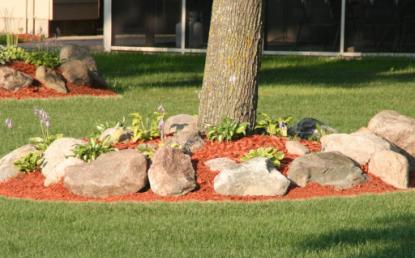
The color-enhanced landscape mulch market continues to grow because of its adaptability to the needs of producers and consumers.

“My mulch operation saved my business.”
“Colored mulch was the only thing that made my company any money this year.”
“Starting a colored mulch operation has been the best investment we’ve ever made, even with the recession.”
This kind of story, well-known to equipment manufacturers like Amerimulch & Rotochopper, demonstrates the resilience of the colored landscape mulch market, as well as the economic optimism that created the colored mulch industry and has allowed it to grow significantly over the last ten years.
The attitudes toward the economy that dominate news stories would suggest that colored landscape mulch would be severely suffering from the housing market downturn, wood fiber shortages, and many other factors. Currently, when people think of wood fiber markets, they are more likely to think of wood pellets, boiler fuel, and other biomass fuel products than landscape mulch, given the growing concern over climate change and energy costs. Yet the colored mulch market continues to offer significant opportunities for a wide range of companies, from international wood product companies to tree care companies with only three employees.
Colored mulch remains a strong and growing market because it delivers many of the same benefits as biomass fuel—affordability, sustainability, and efficiency—though with less public attention. It directly meets consumer demand for economical, eco-friendly products, which has fueled its steady growth over the past five years, even through tough economic conditions. As landscape companies often note, colored mulch is an affordable way to boost the curb appeal of residential and commercial properties. Recently, more homeowners, cautious about major renovations, have turned to mulch as a simple, cost-effective way to improve their outdoor spaces. Consumers also appreciate that colored mulch is a sustainable choice, made primarily from recycled wood waste rather than virgin wood fiber.

Yet the above reasons only partially account for the sustained growth of the colored mulch market. This remains a great market opportunity for a diverse range of companies because of its adaptability to shifting demands. According to long range statistics gathered by Amerimulch, for instance, consumers originally were attracted to colored mulch for its vibrancy, with red as the most popular color. Over time, however, the more natural tones, brown and black, grew more popular as consumers noted the color holding properties of colored mulch, in contrast to natural mulch, which can quickly turn gray.

The landscape mulch market has changed dramatically over the past 20 years. Among all landscape products, colored mulch has been the key to helping supply companies meet shifting customer demands. Simply put, it offers the same advantage to producers as it does to consumers—the flexibility to match a wide range of needs. As market trends evolve and demand for wood fiber rises alongside the growth of biomass markets, the versatility of colored mulch will continue to drive its expansion and long-term success.
